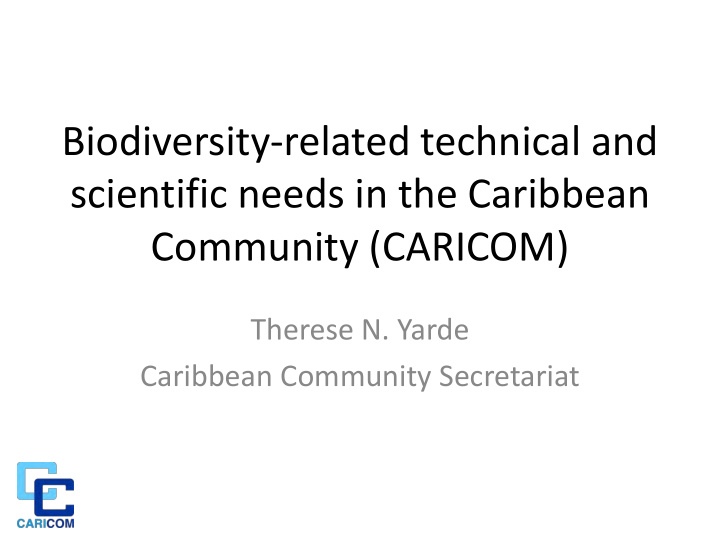



Biodiversity-related technical and scientific needs in the Caribbean Community (CARICOM) Therese N. Yarde Caribbean Community Secretariat
Overview • The Caribbean Community • The role of the CARICOM Secretariat in implementation of the CBD and its Protocols • The CARICOM Framework for ABS Capacity- Building • The CARICOM+ Biodiversity Strategy
CARICOM • A regional integration community, est. in 1973 • 15 members: – Antigua and Barbuda, the Bahamas, Barbados, Belize, Dominica, Grenada, Guyana, Haiti, Jamaica, Montserrat, Saint Lucia, St. Kitts and Nevis, St. Vincent and the Grenadines, Suriname, Trinidad and Tobago • 5 associate members: – Anguilla, Bermuda, British Virgin Islands, Cayman Islands, Turks and Caicos
The CARICOM Secretariat • Develops regional policy and guidance • Coordinates and supports member states at negotiations of the CBD • Provides technical support and advisory services • Builds capacity for implementation of the CBD and other biodiversity MEAs • Raises public awareness • Facilitates cooperation with “third States and competent environment organisations ”
CARICOM ABS Capacity-Building Framework • Outlines key areas where capacity must be built for effective ABS implementation • Initial four priority areas – Awareness raising – Legal frameworks – Institutional arrangements – ABS policies
CARICOM ABS Capacity-Building Framework • New areas for further action – Administrative systems and measures – Information and knowledge management systems – Inventories and valuation of GR and aTK
CARICOM+ Biodiversity Strategy • Will provide a regional consensus to inform regional actions on biodiversity • Will shape the relevant work programmes of the CARICOM Secretariat, OECS Commission, UN Environment, and the CBD Secretariat
CARICOM+ Biodiversity Strategy • Will be used by donors and other stakeholders to guide and structure multi- country biodiversity investment, capacity building, technical assistance, and technology transfer
CARICOM+ Biodiversity Strategy [preliminary identification of needs for technical and scientific cooperation] Using ICT to support production and sharing of national and regional biodiversity-related research, science, information, and knowledge Development and use of national and regional information clearinghouses
CARICOM+ Biodiversity Strategy [preliminary identification of needs for technical and scientific cooperation] Scientific research (including citizen science) on invasive alien species and their impacts, including ecological and economic impacts Biodiversity assessment to identify key biodiversity areas for conservation and protection
CARICOM+ Biodiversity Strategy [preliminary identification of needs for technical and scientific cooperation] Ecosystems services assessments, including research on limits of acceptable change Climate risk assessment for protected areas, and incorporation of adaptation principles and measures into PA management
CARICOM+ Biodiversity Strategy [preliminary identification of needs for technical and scientific cooperation] Use of ecosystems based adaptation approaches for climate resilience Promoting civil society and private sector engagement in biodiversity governance
CARICOM+ Biodiversity Strategy [preliminary identification of needs for technical and scientific cooperation] Natural resources valuation, environmental accounting, and the inclusion of biodiversity values in national accounting processes Development and implementation of biodiversity financing mechanisms, including payment for ecosystems services
THANK YOU Questions?
Recommend
More recommend